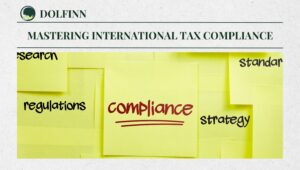
Globalization has opened up endless opportunities for businesses, but with it comes the intricate challenge of international tax compliance. Multinational corporations (MNCs) face a complex web of tax laws, regulations, and reporting standards that vary across jurisdictions. Navigating this landscape requires a clear understanding of global tax frameworks, proactive planning, and strategic decision-making. This guide delves into key international tax considerations, challenges, and strategies for staying compliant while optimizing tax outcomes.
Understanding the Global Tax Landscape
1. Bilateral Tax Treaties
Bilateral tax treaties are agreements between two countries to avoid double taxation and foster economic cooperation. These treaties allocate taxing rights, ensuring that income isn’t taxed twice—once in the source country and again in the residence country. For instance, a U.S.-based company earning profits in India can rely on the U.S.-India tax treaty to prevent double taxation. These treaties also clarify withholding tax rates, capital gains rules, and permanent establishment (PE) definitions.
Example:
A software company headquartered in Germany operates in Brazil. Under the Germany-Brazil tax treaty, the company can claim a tax credit in Germany for taxes paid in Brazil, reducing its overall tax liability.
2. Transfer Pricing
Transfer pricing governs the pricing of transactions between related entities within an MNC. It ensures that these transactions are conducted at arm’s length—the same price as if the entities were unrelated. Transfer pricing is critical for tax authorities to prevent profit shifting and tax base erosion.
Common Methods:
- Comparable Uncontrolled Price (CUP): Compares prices of similar transactions between unrelated parties.
- Resale Price Method: Focuses on the resale margin.
- Cost-Plus Method: Adds a standard markup to production costs.
Failure to comply with transfer pricing regulations can lead to hefty penalties and reputational damage.
3. Base Erosion and Profit Shifting (BEPS)
The OECD’s BEPS framework addresses tax strategies that exploit gaps in tax rules to shift profits to low-tax jurisdictions. With 15 action points, BEPS ensures that profits are taxed where economic activities and value creation occur. Key measures include:
- Country-by-Country Reporting (CbCR): MNCs must disclose revenue, profit, and tax paid for each jurisdiction.
- Hybrid Mismatches: Preventing exploitation of differences in tax systems.
- Digital Economy Taxation: Ensuring fair taxation of digital business models.
4. Value-Added Tax (VAT)
VAT compliance poses unique challenges for MNCs, especially in regions like the European Union (EU), where VAT rates and regulations differ across member states. Companies must determine where VAT is chargeable, register in multiple jurisdictions, and comply with local reporting requirements.
Example:
An e-commerce business selling digital products to EU customers must charge VAT based on the customer’s location and file VAT returns in each applicable country.
Regional Tax Challenges
European Union (EU)
The EU’s efforts to harmonize tax policies often clash with individual member states’ sovereignty. While initiatives like the Common Consolidated Corporate Tax Base (CCCTB) aim to simplify corporate taxation, variations in VAT rates and local rules complicate compliance. Cross-border trade, in particular, demands meticulous planning to avoid double taxation and delays in VAT refunds.
United States
The U.S. Tax Cuts and Jobs Act (TCJA) of 2017 brought significant changes to international taxation. Key provisions include:
- Global Intangible Low-Taxed Income (GILTI): Taxing foreign income exceeding a set return on tangible assets.
- Base Erosion and Anti-Abuse Tax (BEAT): Aimed at reducing profit shifting.
- Foreign-Derived Intangible Income (FDII): Incentives for exporting intellectual property (IP).
Navigating these rules requires careful structuring of foreign operations and regular reviews of tax positions.
Asia-Pacific
The Asia-Pacific region presents a diverse tax environment. While countries like Singapore and Hong Kong offer business-friendly tax regimes, others like India and China impose stricter compliance requirements. MNCs must account for local regulations, tax treaties, and reporting standards to avoid penalties.
Strategies for Effective Compliance
1. Proactive Tax Planning
Tax planning isn’t just about minimizing liabilities; it’s about ensuring compliance with local and international laws. Key strategies include:
- Leveraging tax credits and deductions.
- Structuring transactions to optimize withholding taxes.
- Utilizing tax treaties to reduce double taxation.
Case Study:
A U.K.-based manufacturer with operations in India restructured its royalty payments to benefit from a reduced withholding tax rate under the U.K.-India tax treaty, saving significant costs.
2. Risk Management
Regular audits and risk assessments help identify potential compliance gaps. Establishing robust internal controls and documentation processes ensures transparency and reduces the risk of disputes with tax authorities.
Tips:
- Maintain detailed transfer pricing documentation.
- Conduct periodic reviews of intercompany transactions.
- Stay updated on regulatory changes in key jurisdictions.
3. Technology Adoption
Tax technology solutions streamline compliance by automating calculations, filing returns, and generating reports. Artificial intelligence (AI) tools can analyze vast datasets to identify anomalies, predict risks, and ensure accuracy.
Popular Tools:
- SAP Tax Compliance: Integrates tax reporting with enterprise resource planning (ERP) systems.
- Vertex: Automates VAT and sales tax compliance.
- ONESOURCE: Offers end-to-end tax reporting solutions.
4. Professional Networking
Engaging tax advisors and participating in international tax forums provide valuable insights into emerging trends and best practices. Collaborating with local experts ensures compliance with jurisdiction-specific nuances.
Spotlight: BEPS and the Global Minimum Tax
The OECD’s BEPS initiative has reshaped the global tax landscape, particularly with the introduction of a 15% global minimum tax under Pillar 2. This ensures that large MNCs pay a baseline tax rate, even in low-tax jurisdictions.
Key Features:
- Pillar 1: Allocates taxing rights for large MNCs, especially digital companies.
- Pillar 2: Imposes a minimum tax rate on companies with annual revenues exceeding €750 million.
Compliance with these standards requires robust tax reporting systems and strategic planning to align with local laws.
Implications:
- Increased transparency and accountability.
- Reduced incentives for profit shifting.
- Greater scrutiny from tax authorities.
Common Pitfalls in International Tax Compliance
1. Ignoring Local Regulations
Assuming uniform tax rules across jurisdictions is a costly mistake. Local nuances, such as withholding tax rates or filing deadlines, can lead to penalties if overlooked.
2. Poor Transfer Pricing Practices
Inadequate documentation or unrealistic pricing of intercompany transactions often triggers audits and disputes.
3. VAT Non-Compliance
Failing to register for VAT in applicable countries or misreporting VAT liabilities can result in fines and reputational damage.
4. Reactive Approach
Waiting for regulatory changes to take effect before taking action can leave companies scrambling to comply. Proactive planning is key.
The Role of Technology in Tax Compliance
Technology has revolutionized tax compliance by automating repetitive tasks and enhancing accuracy. Key benefits include:
- Real-Time Reporting: Ensures timely submissions and reduces errors.
- Data Analytics: Identifies trends and potential risks.
- Integration with ERP Systems: Streamlines processes across departments.
Emerging Trends:
- AI and Machine Learning: Predicts compliance risks and recommends solutions.
- Blockchain: Enhances transparency and traceability in transactions.
- Cloud-Based Platforms: Facilitates collaboration across global teams.
Future of International Tax Compliance
The international tax landscape is evolving rapidly, driven by digitalization and globalization. Upcoming trends include:
1. Digital Services Taxes (DST)
Countries are introducing DSTs to tax digital businesses fairly. For instance, India’s Equalization Levy targets foreign e-commerce operators.
2. Enhanced Tax Transparency
Global initiatives like the Common Reporting Standard (CRS) promote the automatic exchange of financial information between countries.
3. ESG Considerations
Environmental, Social, and Governance (ESG) criteria are influencing tax policies. Companies adopting sustainable practices may benefit from tax incentives.
Conclusion
International tax compliance is a dynamic and multifaceted challenge for multinational corporations. By understanding global tax frameworks, adopting proactive strategies, and leveraging technology, businesses can navigate this complex landscape with confidence. Staying informed, engaging experts, and embracing innovation are crucial steps toward achieving compliance while optimizing tax efficiency.
FAQs
1. What is the purpose of bilateral tax treaties?
Bilateral tax treaties prevent double taxation and clarify tax rights between two countries, fostering cross-border trade and investment.
2. How does BEPS impact multinational corporations?
BEPS ensures that profits are taxed where value is created, reducing opportunities for tax avoidance through profit shifting.
3. What are the benefits of using tax technology?
Tax technology automates compliance tasks, reduces errors, and enhances efficiency in reporting and filing.
4. Why is transfer pricing compliance important?
Transfer pricing compliance ensures fair intercompany pricing and prevents disputes with tax authorities.
5. How can companies prepare for the global minimum tax?
Companies should review their tax structures, enhance reporting systems, and seek professional advice to align with OECD standards.
Summary
Navigating international tax compliance can be a daunting challenge for multinational corporations. This guide provides an in-depth look at essential strategies, such as leveraging bilateral tax treaties, mastering transfer pricing, and aligning with the OECD’s BEPS framework, to ensure compliance and optimize tax outcomes.
Latest Posts
- Top Cash Flow Forecasting Tools You Can’t Ignore for Global Businesses

- Mastering Profit vs. Cash Flow: 5 Key Strategies for Financial Success

- 5 Key Advantages and Disadvantages of Outsourced Accounting: Is Outsourced Accounting Worth the Risk?

- Mastering Cash Flow Management in 2025: 7 Proven Strategies for Financial Success

- Mastering International Tax Compliance: 7 Crucial Strategies for Multinational Success

- 5 Common Bookkeeping Mistakes Small Businesses Make and How to Avoid Them

